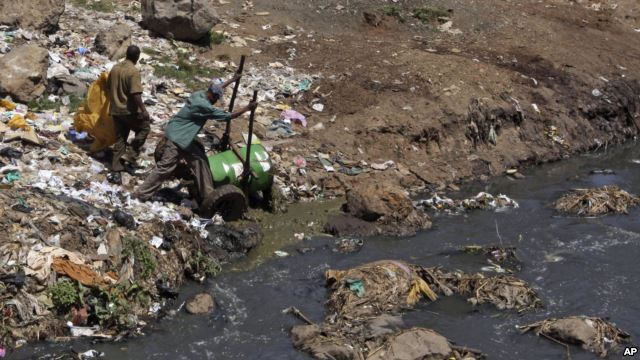
FILE - Workers dump effluent from pit latrines from the Korogocho slum of Nairobi, Kenya into a local water course.

By Jessica Berman
Wednesday, April 09, 2014
A new study by the London School of Hygiene & Tropical Medicine finds that no sub-Saharan African country will meet the U.N. Millennium Development goal for sanitation, and that many are lagging behind achieving the target for clean drinking water as well.
According to a joint report by the World Health Organization and UNICEF last year, more than 2 billion people - or one-third of the world’s population - will remain without access to improved sanitation by 2015. The Millennium goal calls for cutting in half the number of people who lacked clean toileting facilities in 1990.
A study led by British researchers found that none of the countries in sub-Saharan Africa was on track to meet the sanitation goal by next year.
Last year's WHO-UNICEF report noted that the world has met the target of cutting in half the proportion of people without access to improved sources of water, five years ahead of schedule. But that assessment is deceptive, according to Mathew Freeman of Emory University's Rollins School of Public Health in Atlanta. Freeman is co-author of the report by the London School of Hygiene & Tropical Medicine.
He says it appears the global goal of increased access to clean drinking water is largely being met by emerging countries in Asia, which is obscuring the real picture of the availability of adequate water supplies elsewhere.
“China and India, their rapid urbanization and infrastructure investments have led to dramatic changes in access to improved water supply. So, globally that target was met; but, few countries in sub-Saharan Africa have met those targets," said Freeman.
Those few include Gambia, Congo, Gabon, Malawi, Uganda, Burkina Faso, Guinea Bissau and Swaziland.
Many African nations that appear to be on target for reaching Millennium goals, Freeman says, are not taking into account the situation in their poorest, remotest districts.
Investigators say the availability of clean water is highly variable, ranging from 3.2 percent in some districts of Somalia, for example, to as high as 99 percent in Namibia's urban centers. Adequate sanitation facilities are equally inconsistent.
In poorer rural areas, the researchers found, households were two to 18 times less likely to have access to improved sanitation and two to 80 times more likely to defecate in open areas compared to more modern rural areas.
Investigators used statistical models in their analysis of data from 138 national household surveys conducted in 41 sub-Saharan Africa countries between 1991 and 2012.
The authors say making the data on sanitation and drinking water available points up inequities hidden by national statistics. They note it is essential to improve basic infrastructure in areas with the lowest access to clean water and sanitation to prevent the spread of infectious diseases.